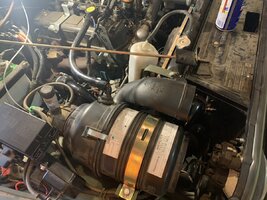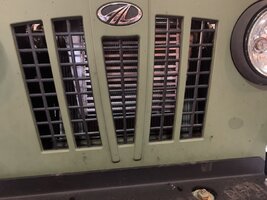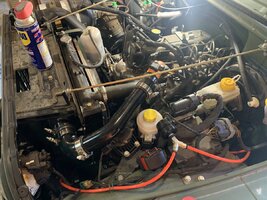I just want to add some thing here.
An intercoolers job is not to cool down your intake or engine at all. Does it help do that, yes, it does, but that is just a byproduct of it doing its main job, and that is to cool down air. It's like a heater core, does a heater core cool down your engine slightly, yes it does, but that's because it is removing that heat from the engine to warm up the passenger compartment, and cooling down your engine slightly is just a byproduct of the heat core doing its main job....and that's warming you up in the winter.
Cooler air is denser air, and denser air means you can get more air into the combustion chamber, and thus more air means more complete burning of the diesel fuel, and that means more power. How much, usually 5% to an extreme of as much as 15% in some cases.
When that cooler air gets inside that engine, you now have MORE air inside the combustion chamber, and now more air is still being compressed at 18 to 1 or higher compression ratio, that air gets HOT HOT HOT, and it has to, or the engine won't run when the injector sprays a mist of diesel fuel inside that HOT air in the combustion chamber.
Now when it comes out of your exhaust, it is not going to be cooler because it went into your engine cooler to begin with. It still has to be compressed at a very high ratio to generate enough heat to fire the diesel when it's injected into the cylinder.
This is just like when people say that wet weather or rain causes their joints to ache. So you need to move out west where it does not rain and you'll feel better and have less pain. Well, they're wrong. It's not the rain or wet, it is the fact that rain usually cools off the air slightly, and makes the air denser, like an intercooler, thus increasing the air pressure slightly and that pressure increase is felt on your joints and it hurts. Moving out to Arizona helps, not because it's dry, it's because it is sunny and HOT and hot air is less dense, and less dense air means less pressure felt on your joints. It's all about air pressure and density, NOT the rain or wet. You sweat to cool off, well the rain is sweat to the air around you and cooling it off.
Compression and the heat generated from it, is what makes the diesel engine work, and this is why gasoline engines have to run at a lower compression ratio like 8 to 1, because if they go higher, the heat generated will cause the air fuel mixture to ignite by itself before the spark plug starts the ignition or firing processes. This is called detonation, and you'll hear it in the form of pinging in your engine. That's because two flame fronts are moving towards each other and when they collide or hit each other, you hear that "PINGING" sound in your engine. One flame front is caused by the air fuel igniting itself due to too high of a compression ratio or too low of octane in the fuel, and the other flame front is started by the spark plug......when they meet, they ping. Detonation is when the air fuel ignites itself, and pre-ignition is when some thing else ignites the air fuel mixture before the spark plug, like a hot piece of carbon build up, but either way it's all pre-ignition and very bad for your engine.
Now octane put in its simplest terms, means the resistance to burn. The higher the octane, the HARDER it is to get that gasoline to ignite. I can't tell you how many times I've heard people say that higher octane fuel gives them more power....it doesn't. It allows you to add components to your engine, like higher compression pistons, turbos, blowers and things like that, and get more power out of your engine, and not risk premature ignition of your air fuel.
Diesel fuel has a rating too, and that's called cetane, but cetane does the opposite of octane, in that the higher the cetane rating, the easier it is to ignite the diesel fuel. It makes diesel fuel burn easier, and this is important in colder weather. Remember, you need A LOT of heat in that combustion chamber for that diesel fuel to ignite and burn, and lowering your intake temps too much is NOT good at all.
Me personally, I would not worry about an intercooler at all or those intake or exhaust temps, unless you're looking to get as much power out of your engine as possible and maybe increase mileage slightly, but you'd only see that as an over the road driver, not farting around in a Roxor on the back roads or back 40. For "ME", the juice just ain't worth the squeeze here, but what the hell do I know.



